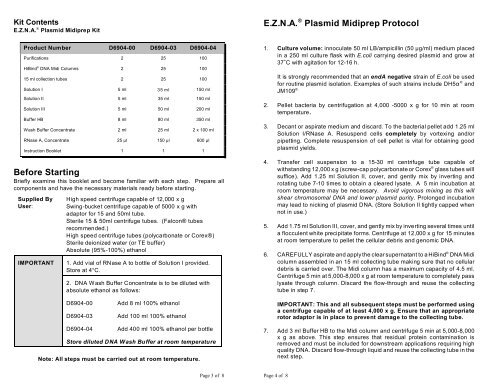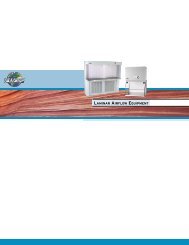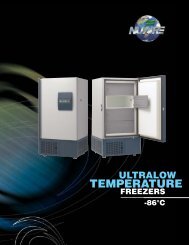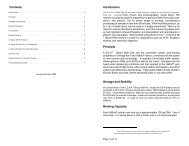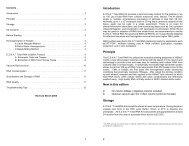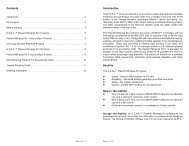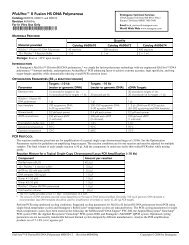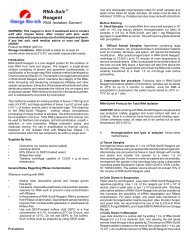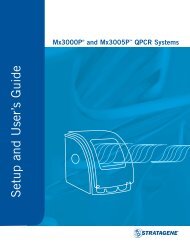E.Z.N.A. ® plasmid midiprep kit Protocol (PDF Version)
E.Z.N.A. ® plasmid midiprep kit Protocol (PDF Version)
E.Z.N.A. ® plasmid midiprep kit Protocol (PDF Version)
You also want an ePaper? Increase the reach of your titles
YUMPU automatically turns print PDFs into web optimized ePapers that Google loves.
Kit Contents<br />
E.Z.N.A. ® Plasmid Midiprep Kit<br />
E.Z.N.A. ® Plasmid Midiprep <strong>Protocol</strong><br />
Product Number D6904-00 D6904-03 D6904-04<br />
Purifications 2 25 100<br />
HiBind ® DNA Midi Columns 2 25 100<br />
15 ml collection tubes 2 25 100<br />
Solution I 5 ml 35 ml 150 ml<br />
Solution II 5 ml 35 ml 150 ml<br />
Solution III 5 ml 50 ml 200 ml<br />
Buffer HB 8 ml 80 ml 350 ml<br />
Wash Buffer Concentrate 2 ml 25 ml 2 x 100 ml<br />
RNase A, Concentrate 25 l 150 l 600 l<br />
Instruction Booklet 1 1 1<br />
Before Starting<br />
Briefly examine this booklet and become familiar with each step. Prepare all<br />
components and have the necessary materials ready before starting.<br />
Supplied By<br />
User:<br />
IMPORTANT<br />
High speed centrifuge capable of 12,000 x g<br />
Swing-bucket centrifuge capable of 5000 x g with<br />
adaptor for 15 and 50ml tube.<br />
Sterile 15 & 50ml centrifuge tubes. (Falcon® tubes<br />
recommended.)<br />
High speed centrifuge tubes (polycarbonate or Corex®)<br />
Sterile deionized water (or TE buffer)<br />
Absolute (95%-100%) ethanol<br />
1. Add vial of RNase A to bottle of Solution I provided.<br />
Store at 4 o C.<br />
2. DNA Wash Buffer Concentrate is to be diluted with<br />
absolute ethanol as follows:<br />
D6904-00 Add 8 ml 100% ethanol<br />
D6904-03 Add 100 ml 100% ethanol<br />
D6904-04 Add 400 ml 100% ethanol per bottle<br />
Store diluted DNA Wash Buffer at room temperature<br />
Note: All steps must be carried out at room temperature.<br />
1. Culture volume: innoculate 50 ml LB/ampicillin (50 g/ml) medium placed<br />
in a 250 ml culture flask with E.coli carrying desired <strong>plasmid</strong> and grow at<br />
37C with agitation for 12-16 h.<br />
It is strongly recommended that an endA negative strain of E.coli be used<br />
for routine <strong>plasmid</strong> isolation. Examples of such strains include DH5 ® and<br />
JM109 ®.<br />
2. Pellet bacteria by centrifugation at 4,000 -5000 x g for 10 min at room<br />
temperature.<br />
3. Decant or aspirate medium and discard. To the bacterial pellet add 1.25 ml<br />
Solution I/RNase A. Resuspend cells completely by vortexing and/or<br />
pipetting. Complete resuspension of cell pellet is vital for obtaining good<br />
<strong>plasmid</strong> yields.<br />
4. Transfer cell suspension to a 15-30 ml centrifuge tube capable of<br />
withstanding 12,000 x g (screw-cap polycarbonate or Corex ® glass tubes will<br />
suffice). Add 1.25 ml Solution II, cover, and gently mix by inverting and<br />
rotating tube 7-10 times to obtain a cleared lysate. A 5 min incubation at<br />
room temperature may be necessary. Avoid vigorous mixing as this will<br />
shear chromosomal DNA and lower <strong>plasmid</strong> purity. Prolonged incubation<br />
may lead to nicking of <strong>plasmid</strong> DNA. (Store Solution II tightly capped when<br />
not in use.)<br />
5. Add 1.75 ml Solution III, cover, and gently mix by inverting several times until<br />
a flocculent white precipitate forms. Centrifuge at 12,000 x g for 15 minutes<br />
at room temperature to pellet the cellular debris and genomic DNA.<br />
6. CAREFULLY aspirate and apply the clear supernatant to a HiBind ® DNA Midi<br />
column assembled in an 15 ml collecting tube making sure that no cellular<br />
debris is carried over. The Midi column has a maximum capacity of 4.5 ml.<br />
Centrifuge 5 min at 5,000-8,000 x g at room temperature to completely pass<br />
lysate through column. Discard the flow-through and reuse the collecting<br />
tube in step 7.<br />
IMPORTANT: This and all subsequent steps must be performed using<br />
a centrifuge capable of at least 4,000 x g. Ensure that an appropriate<br />
rotor adaptor is in place to prevent damage to the collecting tube.<br />
7. Add 3 ml Buffer HB to the Midi column and centrifuge 5 min at 5,000-8,000<br />
x g as above. This step ensures that residual protein contamination is<br />
removed and must be included for downstream applications requiring high<br />
quality DNA. Discard flow-through liquid and reuse the collecting tube in the<br />
next step.<br />
Page 3 of 8<br />
Page 4 of 8


